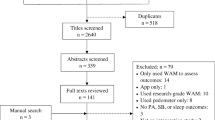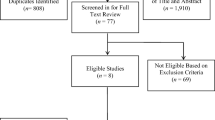Abstract
Backgrounds
This study aimed to explore the effect on physical activity and sedentary behavior of users of wearable devices, and understand the association between physical activity and behavior.
Methods
This study conducted a three-arm, randomized controlled trial for 12 weeks. Healthy adults without experience of using a wearable device were recruited and were randomly assigned to a control group with a mobile app and two experimental groups with different smart wearable devices. Data were collected through questionnaires.
Results
No significant effect of group, time, or group-by-time interaction among groups for physical activity, sedentary time, or sleep quality was found. Wearing duration significantly positively predicted changes in low-intensity and total physical activity. The number of times the device was checked negatively predicted a change in sedentary time.
Conclusions
The behavior of wearable device users is an essential factor for successfully increasing physical activity and decreasing sedentary time.

Similar content being viewed by others
References
Lee IM, Shiroma EJ, Lobelo F, Puska P, Blair SN, Katzmarzyk PT, et al. Effect of physical inactivity on major non-communicable diseases worldwide: an analysis of burden of disease and life expectancy. Lancet. Elsevier Ltd; 2012;380:219–29. Available from: http://dx.doi.org/10.1016/S0140-6736(12)61031-9
Ding D, Lawson KD, Kolbe-Alexander TL, Finkelstein EA, Katzmarzyk PT, van Mechelen W, et al. The economic burden of physical inactivity: a global analysis of major non-communicable diseases. Lancet. 2016.
Torjesen I. Global cost of physical inactivity is estimated at $67.5bn a year. BMJ. 2016.
Reis RS, Salvo D, Ogilvie D, Lambert EV, Goenka S, Brownson RC. Scaling up physical activity interventions worldwide: stepping up to larger and smarter approaches to get people moving. Lancet. 2016.
Piwek L, Ellis DA, Andrews S, Joinson A. The rise of consumer health wearables: promises and barriers. PLoS Med. 2016;13:1–9.
Coughlin SS, Caplan LS, Stone R. Use of consumer wearable devices to promote physical activity among breast, prostate, and colorectal cancer survivors: a review of health intervention studies. J CANCER Surviv. 2020;14:386–92.
Sullivan AN, Lachman ME. Behavior change with fitness technology in sedentary adults: a review of the evidence for increasing physical activity. Front Public Heal [Internet]. 2017;4:1–16. Available from: http://journal.frontiersin.org/article/10.3389/fpubh.2016.00289/full
Cellini N, McDevitt EA, Mednick SC, Buman MP. Free-living cross-comparison of two wearable monitors for sleep and physical activity in healthy young adults. Physiol Behav. Elsevier Inc.; 2016;157:79–86. Available from: http://dx.doi.org/10.1016/j.physbeh.2016.01.034
Naslund JA, Aschbrenner KA, Bartels SJ. Wearable devices and smartphones for activity tracking among people with serious mental illness. Ment Health Phys Act. 2016;10:10–7.
Kim Y, Lumpkin A, Lochbaum M, Stegemeier S, Kitten K. Promoting physical activity using a wearable activity tracker in college students: a cluster randomized controlled trial. J Sports Sci. Routledge; 2018;36:1889–96. Available from: https://doi.org/10.1080/02640414.2018.1423886
Bandura A. Health promotion by social cognitive means. Heal. Educ. Behav. 2004.
Chaddha A, Jackson EA, Richardson CR, Franklin BA. Technology to help promote physical activity. Am J Cardiol. 2017;119:149–52.
Pyky R, Koivumaa-Honkanen H, Leinonen A, Timo J. Computers in human behavior effect of tailored, gamified, mobile physical activity intervention on life satisfaction and self-rated health in young adolescent men: a population-based, randomized controlled trial (MOPO study). 2017;72.
Jakicic JM, Davis KK, Rogers RJ, King WC, Marcus MD, Helsel D, et al. Effect of wearable technology combined with a lifestyle intervention on long-term weight loss: the IDEA randomized clinical trial. JAMA - J Am Med Assoc. 2016;316:1161–71.
Mascarenhas MN, Chan JM, Vittinghoff E, Van Blarigan EL, Hecht F. Increasing physical activity in mothers using video exercise groups and exercise mobile apps: Randomized controlled trial. J Med Internet Res. 2018;20:1–14.
Rose T, Barker M, Maria Jacob C, Morrison L, Lawrence W, Strömmer S, et al. A systematic review of digital interventions for improving the diet and physical activity behaviors of adolescents. J Adolesc Heal. 2017;61:669–77.
Lee SY, Lee K. Factors that influence an individual’s intention to adopt a wearable healthcare device: the case of a wearable fitness tracker. Technol Forecast Soc Change. 2018;129:154–63.
Schueller SM, Tomasino KN, Mohr DC. Integrating human support into behavioral intervention technologies: the efficiency model of support. Clin Psychol Sci Pract. 2017;24:27–45.
Guthold R, Ono T, Strong KL, Chatterji S, Morabia A. Worldwide variability in physical inactivity. A 51-Country Survey. Am J Prev Med. 2008;34:486–94.
Most EI, Scheltens P, Van Someren EJ. Prevention of depression and sleep disturbances in elderly with memory-problems by activation of the biological clock with light - a randomized clinical trial. Trials. 2010;11:19.
Cohen J. Statistical power analysis for the behavioural science (2nd Edition). Stat. Power Anaylsis Behav. Sci. 1988.
Pope Z, Zeng N, Zhang R, Lee H, Gao Z. Effectiveness of combined smartwatch and social media intervention on breast cancer survivor health outcomes: a 10-week pilot randomized trial. J Clin Med. 2018;7:140. Available from: http://www.mdpi.com/2077-0383/7/6/140
Ashton LM, Morgan PJ, Hutchesson MJ, Rollo ME, Collins CE. Feasibility and preliminary efficacy of the “HEYMAN” healthy lifestyle program for young men: a pilot randomised controlled trial. Nutr J. 2017;16:2.
Fukuoka Y, Gay CL, Joiner KL, Vittinghoff E. A novel diabetes prevention intervention using a mobile app. Am J Prev Med. Elsevier; 2015;49:223–37. Available from: https://doi.org/10.1016/j.amepre.2015.01.003
Jauho AM, Pyky R, Ahola R, Kangas M, Virtanen P, Korpelainen R, et al. Effect of wrist-worn activity monitor feedback on physical activity behavior: a randomized controlled trial in Finnish young men. Prev Med Reports. Elsevier B.V.; 2015;2:628–34. Available from: http://dx.doi.org/10.1016/j.pmedr.2015.07.005
Greenfield R, Busink E, Wong CP, Riboli-Sasco E, Greenfield G, Majeed A, et al. Truck drivers’ perceptions on wearable devices and health promotion: a qualitative study. BMC Public Health. 2016;16:1–11.
Lee I, Shiroma EJ, Evenson KR, Lacroix AZ, Buring JE. Using devices to assess physical activity and sedentary behavior in a large cohort study: the women’s health study. J Meas Phys Behav. 2018;1:60–9.
Sloan RA, Kim Y, Sahasranaman A, Müller-Riemenschneider F, Biddle SJH, Finkelstein EA. The influence of a consumer-wearable activity tracker on sedentary time and prolonged sedentary bouts: secondary analysis of a randomized controlled trial NCT01855776 NCT. BMC Res Notes. BioMed Central; 2018;11:1–6. Available from: https://doi.org/10.1186/s13104-018-3306-9
Gualtieri L, Rosenbluth S, Phillips J. Can a free wearable activity tracker change behavior? The impact of trackers on adults in a physician-led wellness group. JMIR Res Protoc. 2016;5:e237.
Funding
This work was supported by the Ministry of Science and Technology, Taiwan under Grant (MOST 108–2314-B-038–011).
Author information
Authors and Affiliations
Corresponding author
Ethics declarations
Ethical Approval
All procedures performed in studies involving human participants were in accordance with the ethical standards of the institutional and/or national research committee and with the 1964 Helsinki declaration and its later amendments or comparable ethical standards. This study was obtained from the Taiwan Medical University-Joint Institutional Review Board (N201809037).
Informed Consent
Informed consent was obtained from all individual participants included in the study.
Conflict of Interest
The authors declare no competing interests.
Additional information
Publisher's Note
Springer Nature remains neutral with regard to jurisdictional claims in published maps and institutional affiliations.
Supplementary Information
Below is the link to the electronic supplementary material.
Rights and permissions
About this article
Cite this article
Yen, HY., Liao, Y. & Huang, HY. Smart Wearable Device Users’ Behavior Is Essential for Physical Activity Improvement. Int.J. Behav. Med. 29, 278–285 (2022). https://doi.org/10.1007/s12529-021-10013-1
Accepted:
Published:
Issue Date:
DOI: https://doi.org/10.1007/s12529-021-10013-1




